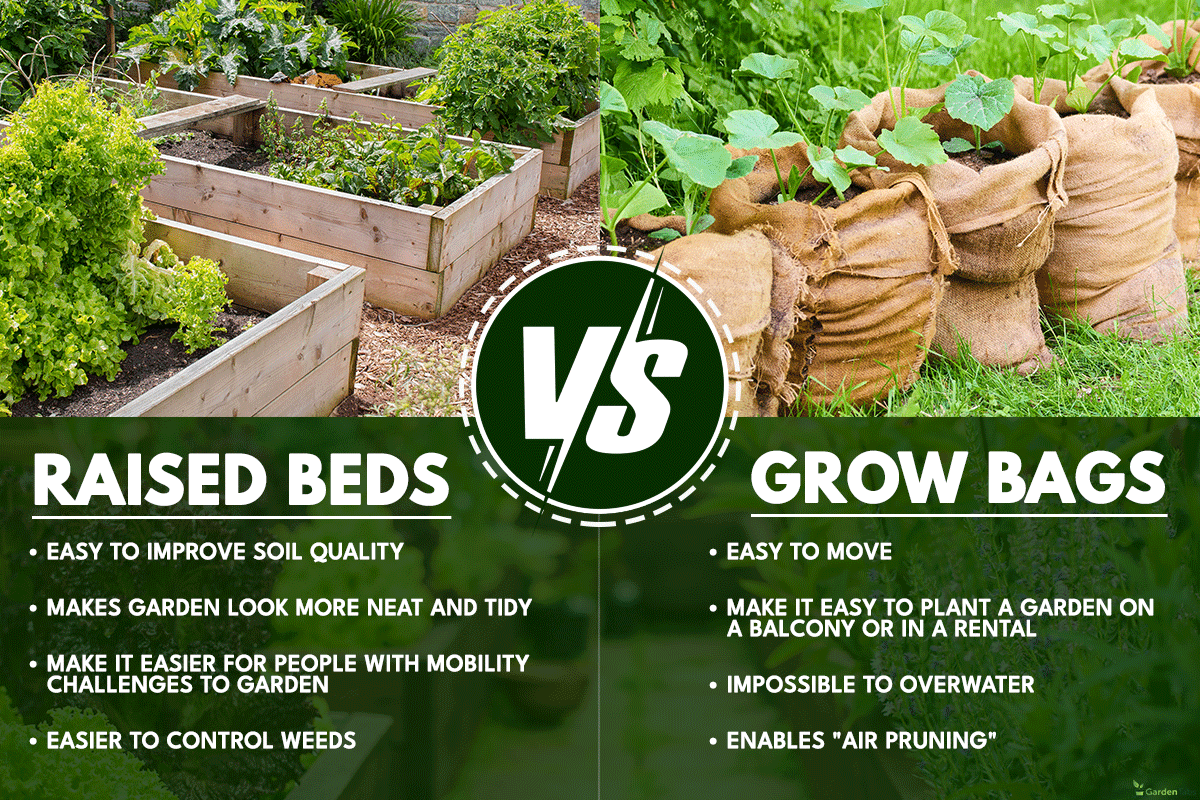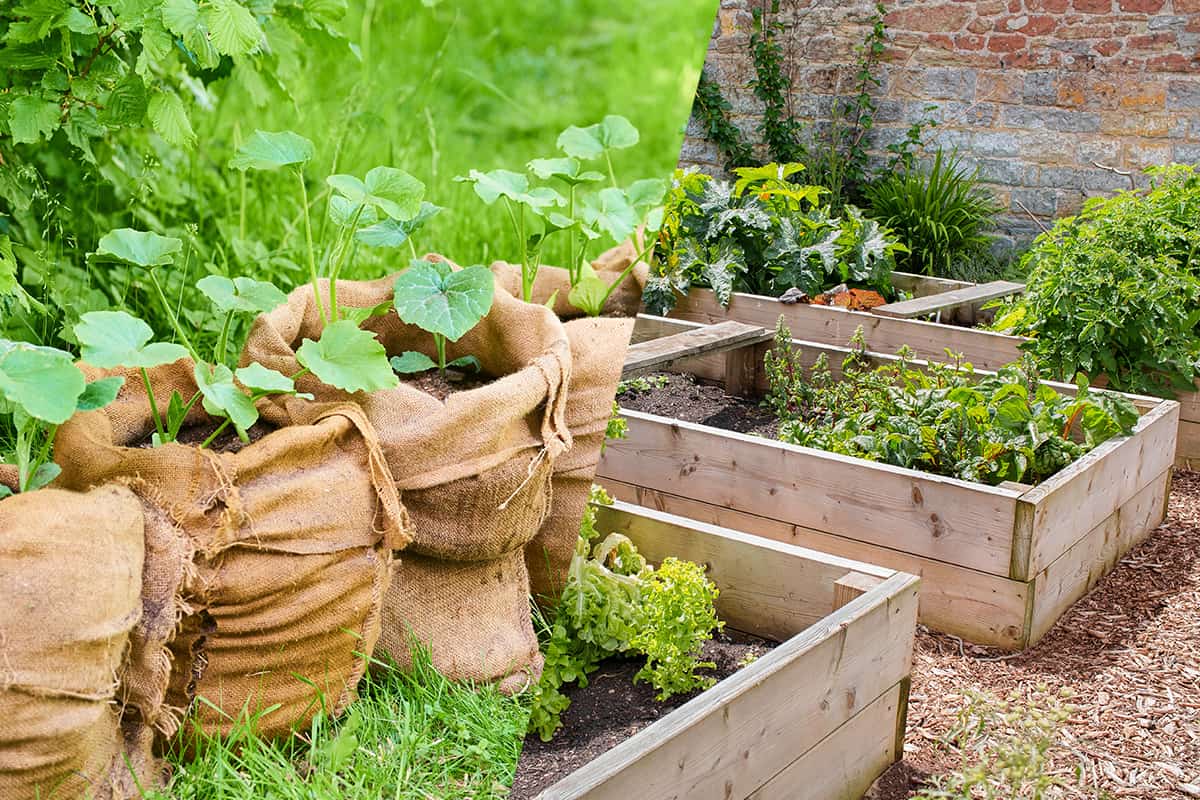Raised beds, grow bags, traditional beds—there are so many great ways to build a garden that provides your plants with the best possible growing conditions. However, so many options can leave you wondering which is best. Well, don't worry—we've done the research and figured out all the pros and cons so you can make an educated decision for your garden.
Whether grow bags or raised beds are better depends on your garden's needs. Grow bags are a great choice if you need to easily move your plants or are using a small or rented space. Raised beds are better if you need a permanent garden bed or want to match your plants to specific soil types. Both are helpful if you have poor soil quality, need more growing space, or want an easier gardening experience.
In this article, we'll walk you through the pros and cons of grow bags and raised beds in more detail. By the end, you'll have a good understanding of the strengths and weaknesses of each and will be able to decide which one is the right choice for you.

What Are The Advantages Of Raised Garden Beds?
Raised garden beds have become very popular over the past few decades and for good reason. They make it simple to improve soil quality, create an organized garden, and increase the accessibility of gardening. Let's look at some of the top advantages of using raised garden beds.

It's Easy To Improve Soil Quality
Even if the ground is a little too sandy or clay-filled for the plants you'd like to grow, you can fill your raised beds with high-quality soil. You can also tailor the soil to fit the needs of the specific plants growing in the bed.
Your Garden Will Look More Neat And Tidy
Raised beds give gardens a structured, architectural look. The increased height also prevents plants from spilling onto the pathways and getting stepped on.
Raised Beds Make It Easier For People With Mobility Challenges To Garden
If you or someone you know uses a wheelchair or has difficulty bending over or kneeling, a raised garden bed might be a great way to make gardening more comfortable and enjoyable. You can even construct them like a table to lift the entire garden up to a convenient height.
It's Easier To Control Weeds
Since raised beds sit on top of the ground, weeds that send out runner roots won't be able to infiltrate your garden.
For maximum weed-fighting potential, you can even build your raised bed on top of a piece of landscape fabric.
This landscape fabric is 3 feet x 50 feet, which gives you plenty of material to help discourage weeds.
Click here to view it on Amazon.
Additionally, adding a hardware cloth to the bottom of your raised bed means you can protect your plants not only from weeds but burrowing animals, too. Check out our article What Size Hardware Cloth Do I Need For A Raised Bed [& How To Attach It]? to learn more.
What Are The Advantages Of Grow Bags?

For affordability, mobility, and ease, you can't beat a grow bag. Usually made from felt or another non-woven, pressed fabric, grow bags come in many different sizes to suit your needs.
Some are even made from biodegradable materials, making them especially eco-friendly.
Gardzen's grow bags are available in nine different sizes from 1 to 25 gallons and have handles to make them easy to move.
Click here to view them on Amazon.
Here are some of the best things about grow bags:
Grow Bags Are Easy To Move
A great feature of grow bags is that they are easy to carry or drag to a new location. Be warned, though - large bags with a 50 lb. or higher capacity might be hard to budge!
Grow Bags Make It Easy To Plant A Garden On A Balcony Or In A Rental
Since grow bags are easy to remove, you can use them to grow plants in unlikely places. This means that even if you rent your home or have a tiny area to work with, you don't have to give up your gardening dreams!
It's Impossible To Overwater
Since grow bags are made of fabric, they're completely porous. Therefore, any excess water will simply drain away instead of being trapped against the plant's roots.
Grow Bags Enable "Air Pruning"
When a plant grows in a too-small pot, its roots often grow until they fill all available space. This is referred to as being root bound, and can kill plants.
In a grow bag, on the other hand, the ends of the roots naturally dry up and fall off as they're exposed to non-humid air. This encourages new root branches to grow, which in turn improves the overall health of the plant.
Grow bags are very popular for growing a number of vegetables, including tomatoes, potatoes, and peppers. Read our article What Size Grow Bag For Potatoes? to learn all you'll need to know about planting potatoes in a grow bag.
What Are The Disadvantages Of Raised Garden Beds?

Along with the many useful features of raised beds come a few disadvantages. Concerns about raised beds usually center around their permanence and high cost of installation. There are also some other potential problems, including:
Raised Beds Require More Watering
Raised garden beds often have superior drainage capabilities compared to in-ground gardens, but this comes at the cost of more frequent watering. Plus, since plants tend to grow more quickly in raised beds, they also consume more water.
Raised Beds Cost Money To Build

Unlike a traditional in-ground garden where you often only need to till the soil before planting, raised beds cost money. You'll need to buy lumber or whatever material you've chosen for the sides, along with soil to fill them.
Your Plants' Roots Might Not Be Able To Reach Their Full Potential
People often build raised beds to avoid the poor-quality soil beneath them. However, keep in mind that the roots of some plants, including tomatoes and peppers, have roots up to 4 feet long.
This means that even if your raised bed is 24 inches high, half of the roots will still be growing into poor soil. Because of this, the roots might end up weaker and shorter, which will damage your plant's overall health.
Raised Beds Are Not As Environmentally Friendly Because You Have To Transport Soil And Raised Bed Materials
Transportation is one of the biggest pollution sources on the planet. When you buy lumber and soil, they had to be transported from somewhere to reach you, which created a large carbon footprint. Plus, logging for lumber is a leading cause of deforestation.
What Are The Disadvantages Of Grow Bags?

Although grow bags can be a great solution for people who need a simple, easily moveable way to grow plants, they are not perfect.
Some of their best features, like porousness and convenient construction, also have significant drawbacks. Keep reading to find out if the disadvantages of grow bags are a problem for you.
Grow Bags Are Not As Aesthetically Pleasing As Raised Beds Or Pots
Let's face it—a simple black, brown, or gray grow bag just isn't as cute as a clay pot or wood-lined raised bed. If looks don't bother you, great! But if you're selective about your garden's appearance, be aware that grow bags are not typically available in patterns or fun colors.
Grow Bags Aren't Always Made From Eco-Friendly Materials
Some grow bags are made to biodegrade at the end of their lifespan, but this unfortunately isn't true of all. And since they wear out after a few years, this could add up to a lot of trash.
The Soil Dries Out More Quickly
The porousness of grow bags can enhance the health of your plants' roots, but it can also create problems. Similarly to raised beds, your plants will need to be watered more often than if they were growing in a traditional in-ground garden.
So much water usage can also raise environmental concerns, especially if you live in a drought-prone area.
Grow Bags Leave Plants Vulnerable To The Cold
Since grow bags are so porous, they also leave plants vulnerable to the cold. This might not be an issue if you live in a warm climate, but it's worth considering if you're in a cold part of the world. Luckily, though, it's easy to move grow bags, so you could bring them into a greenhouse or shed as the weather cools.
In Closing

The answer to the question of whether raised beds or grow bags are better depends on your needs. Raised beds are great if you want a structured, permanent garden. On the other hand, grow bags may be the answer if you need something affordable and easily moved.
Both offer the potential for superior draining and soil quality, and both have environmental concerns associated with them. We hope this article helped you decide which option is best for you and your garden!



Great article. Thoughtful, and insightful. Looking forward to the next one.
Best Regards,
Gloria